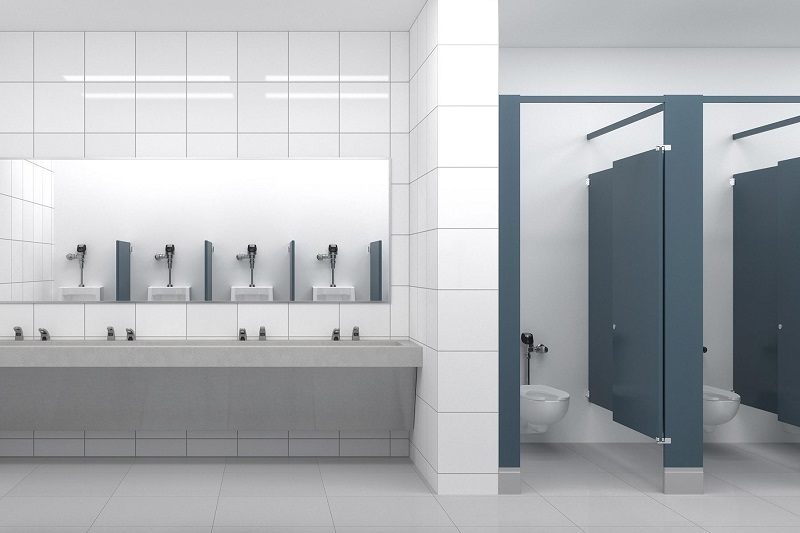With hand hygiene top of mind for everyone across the country, facility managers are rapidly replacing their existing manual commercial restroom products in favor of touch-free applications. As a leader in touch-free technology since it introduced the first hands-free sensor faucet in 1974, Sloan is working to make the transition from manual to automatic a seamless one. Sloan’s Morgan Butts, Product Line Manager, Faucets, Sinks, Soap Dispensers, and Hand Dryers and Mark Lawinger, Senior Product Line Manager, Flushometers and Fixtures provide insights on how to best optimize the retrofit process.
Have you noticed an increase in entire restroom retrofits, or just select product upgrades (or both)?
Lawinger – We have seen a major increase in retrofits across the entire restroom, specifically faucets and flushometers. This trend has been primarily driven by the COVID-19 pandemic and the desire to specify touch-free restroom products that help minimize the risk of cross-contamination. Retrofitting manual faucets and flushometers from manual to sensor technology is an easy way to achieve maximum hygiene while also updating the restroom’s overall aesthetic. In addition to retrofitting specific products, we’re seeing a shift in entire restroom configurations to allow for increased privacy and social distancing. Facilities are now constructing restrooms with additional fixtures than what’s required by code to enhance social distancing measures, while wall-to-ceiling stalls and separation or privacy panels between sinks are also emerging trends.
Butts – More of our customers are updating and renovating their restrooms to touch-free products. Some are taking the opportunity of current lower occupancy to do large-scale renovations, but many are just updating faucets, soap dispensers, hand dryers, and flushometers to touch-free options.
What benefits do complete restroom retrofits deliver to the restroom?
Butts – A full retrofit can provide updates to the aesthetics which in turn improves the perception of the entire building. Retrofits also give the facility the ability to upgrade to a touch-free environment throughout the whole restroom. The fewer restroom products that people have to touch, the healthier and happier they will be.
What tips would you give to facilitate an effective retrofit?
Lawinger – It’s important to understand your building’s current infrastructure in terms of water supply pressure and quality as well as the drainage situation. As buildings age, the condition of these pipes can build up scale and debris. When this is the case, such older buildings can no longer support the needed conditions to effectively retrofit with new higher efficiency products. That’s why it’s crucial to have a clear objective and then make your product selections with those goals in mind.
Butts –In addition to Mark’s point, it’s also important to know what you intend to change and what you won’t prior to making product decisions. For instance, are you adding power under the sink? If so, you can now choose from hardwired faucets and even opt for integrated sinks, like the Sloan AER-DEC®. Next would be to understand your budget. Sloan has products for every price point, but it’s important to choose the right ones for your budget.
What other catalysts have sparked the increase in retrofits (if any) aside from the increased importance placed on hand hygiene?
Lawinger – For starters, interest in higher water efficiency has been on the rise for over 10 years. Recognition that water is a valuable commodity has driven many green codes and standards, and the public values these initiatives. Additionally, we are seeing more attention being paid to the overall design aesthetic of the commercial restroom as a way to differentiate the space. Tenants value a clean, attractive restroom environment, and thus the restroom area can become a value-added space.
Facility managers also want products that can help them manage their water “smarter” and more effectively. Sloan’s expanded lineup of connected faucets and flushometers now utilize Bluetooth connectivity to bring managing water usage right to your fingertips. When paired with the Sloan Connect® App, facility maintenance teams can adjust and configure faucets and flushometers right from their smartphone to save time and money, troubleshoot issues, and reduce risk.
What Sloan products provide the best solutions for a touch-free retrofit?
Butts – Sloan’s faucets and soap dispensers are the best place to start for a simple and easy retrofit. Most spaces can typically remove their existing products and replace them with new Sloan touch-free units with minimal work or time to change. Flushometer retrofits are also simple and easy for buildings that aren’t looking for a major renovation. For buildings considering larger retrofits, upgrading to sinks such as the SloanStone® or Designer Series™ Gradient (ELGR or DSG) sinks is a great way to give your space a fresh, new look.
This is the 21st edition in a series of Q&A segments with Sloan subject matter experts for their take on where the commercial restroom has been, what it’s evolved to now, and where it’s headed. A previous podcast edition on Matching Functionality and Aesthetics with Sloan’s Collections Series can be found here.
Stay Up to Date
Sign up for the Sloan blog to receive information on the latest trends in commercial building, technology advancements and product updates. It's the leading source of industry news for architects, designers, engineers and contractors.
